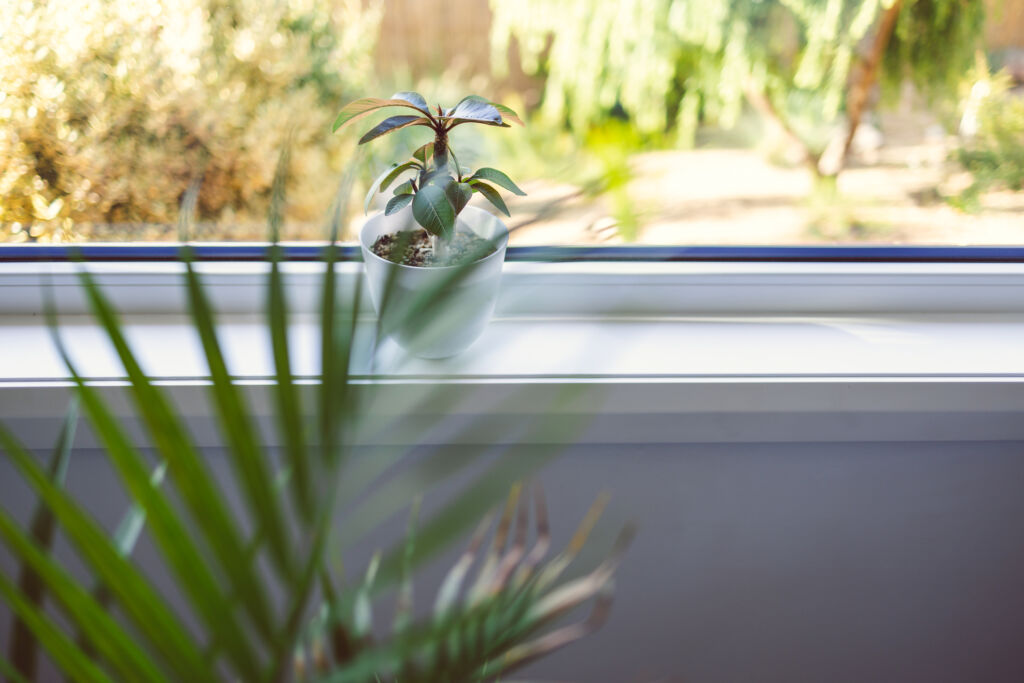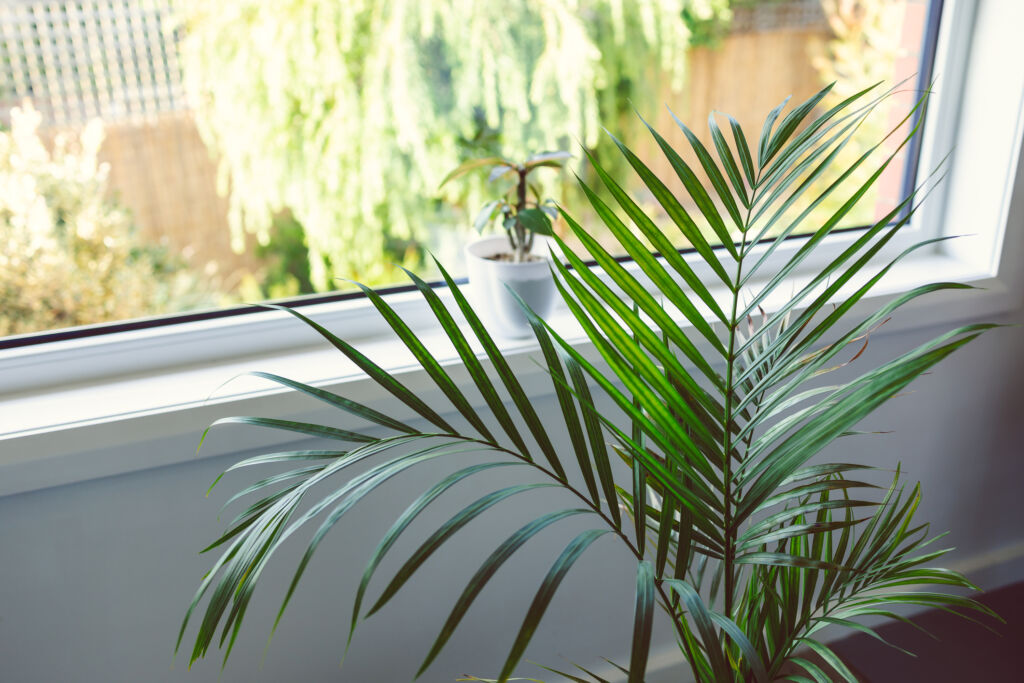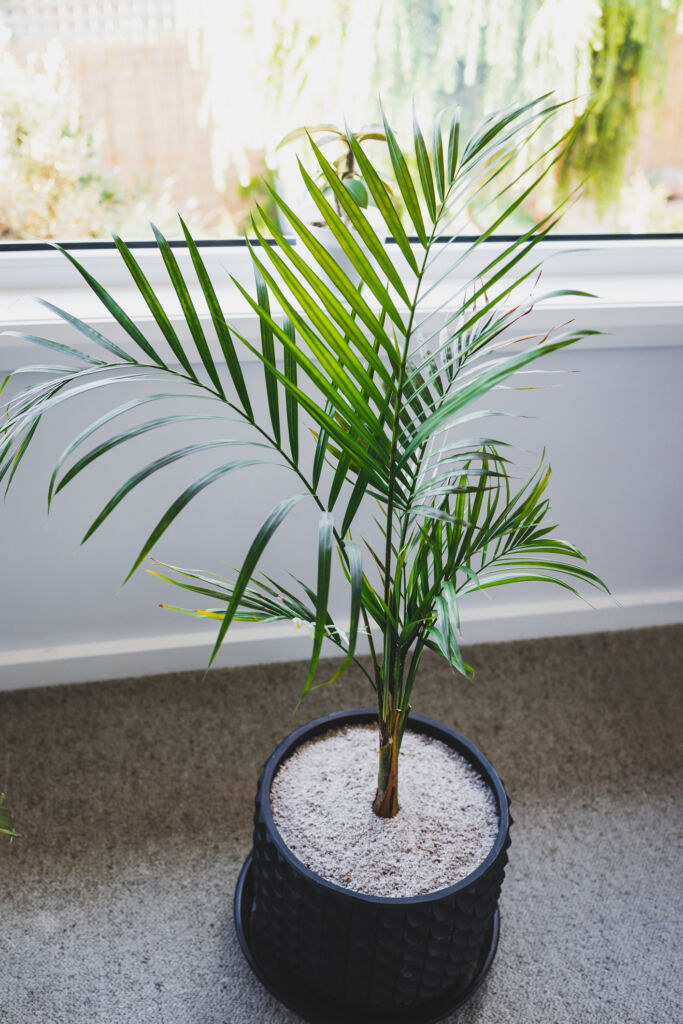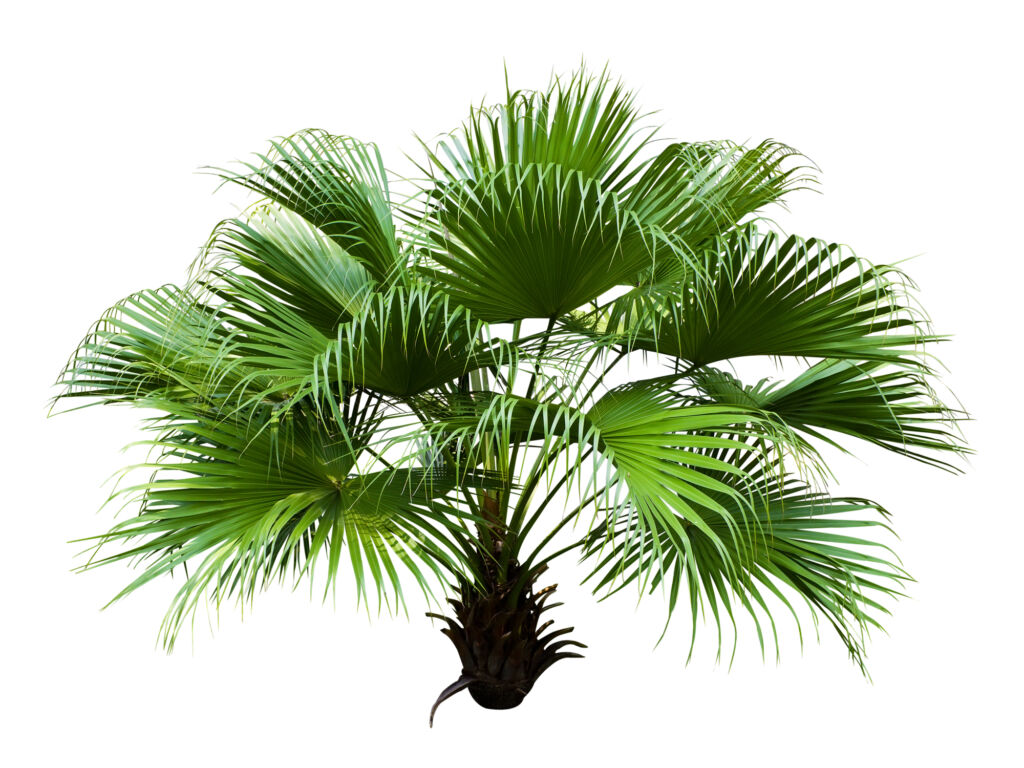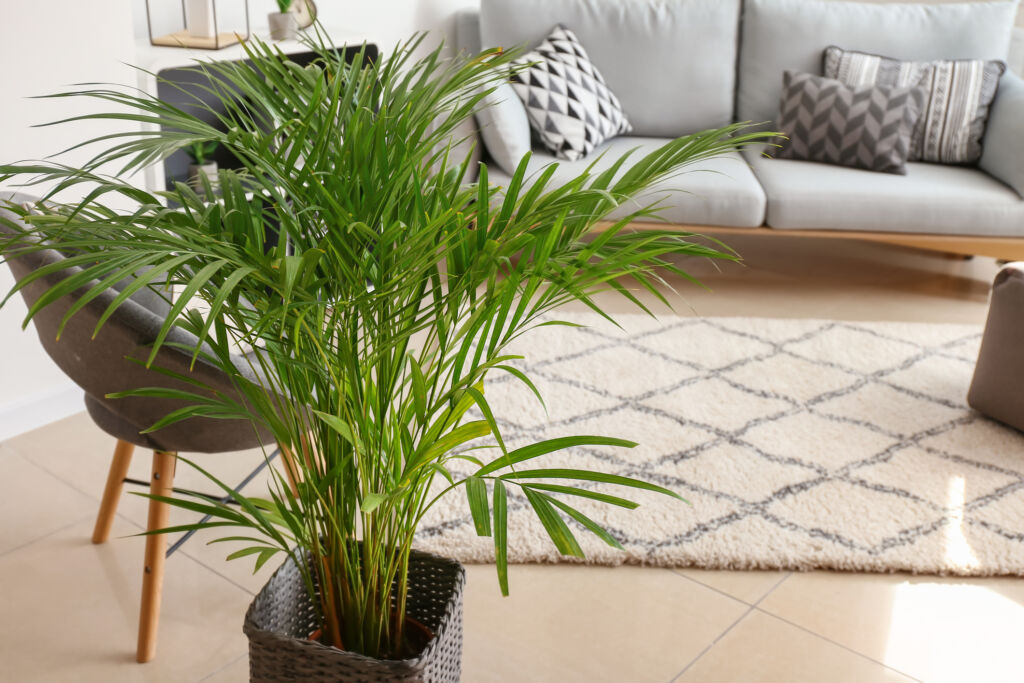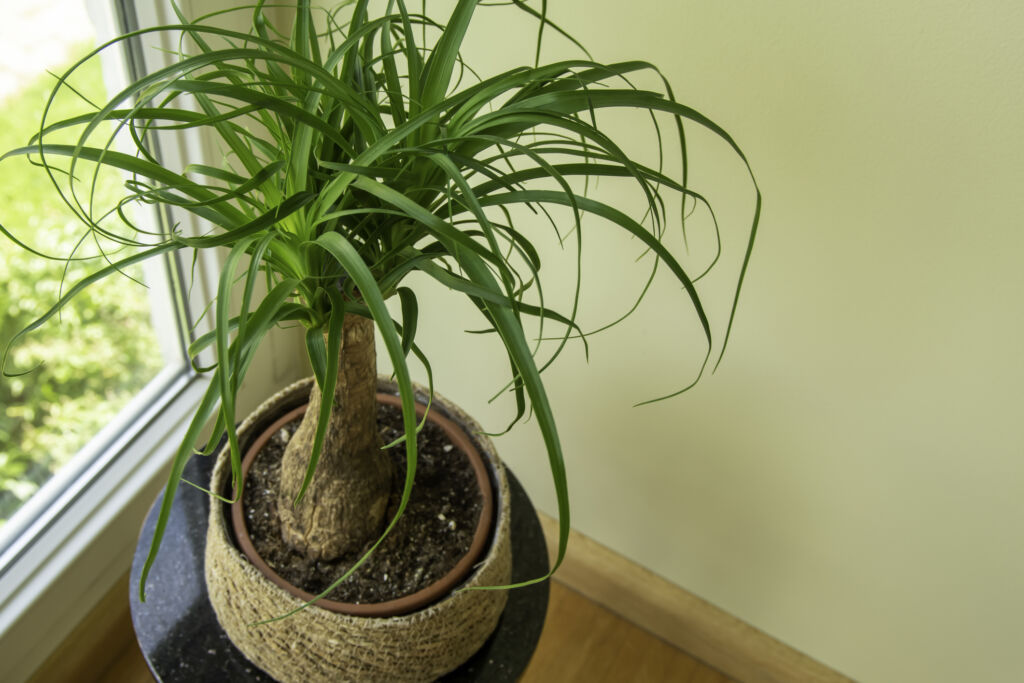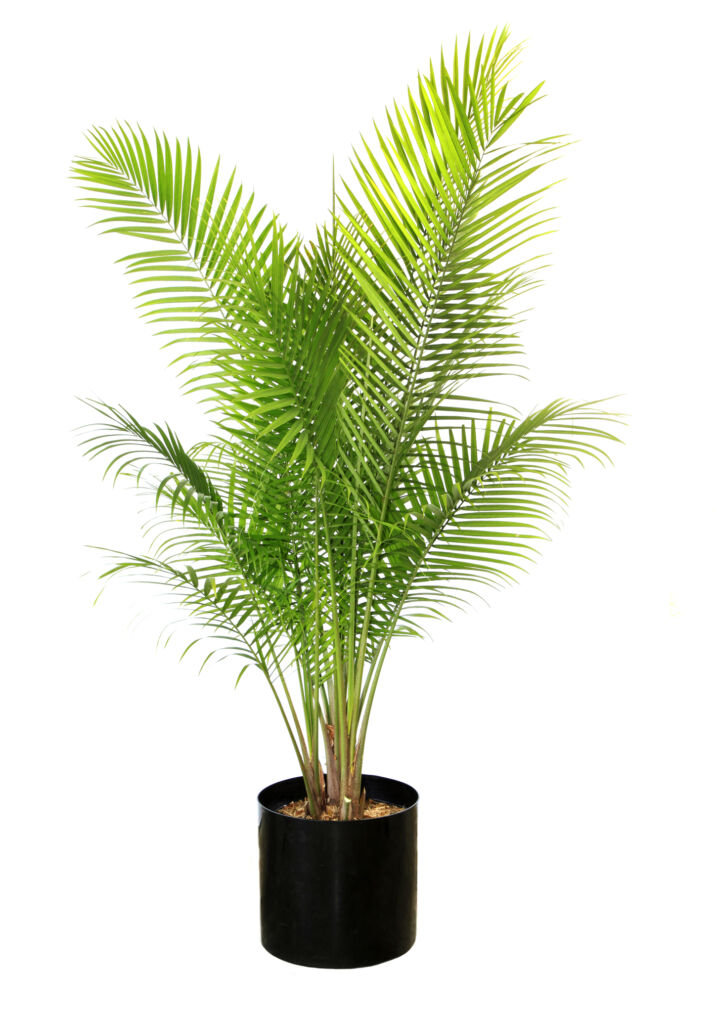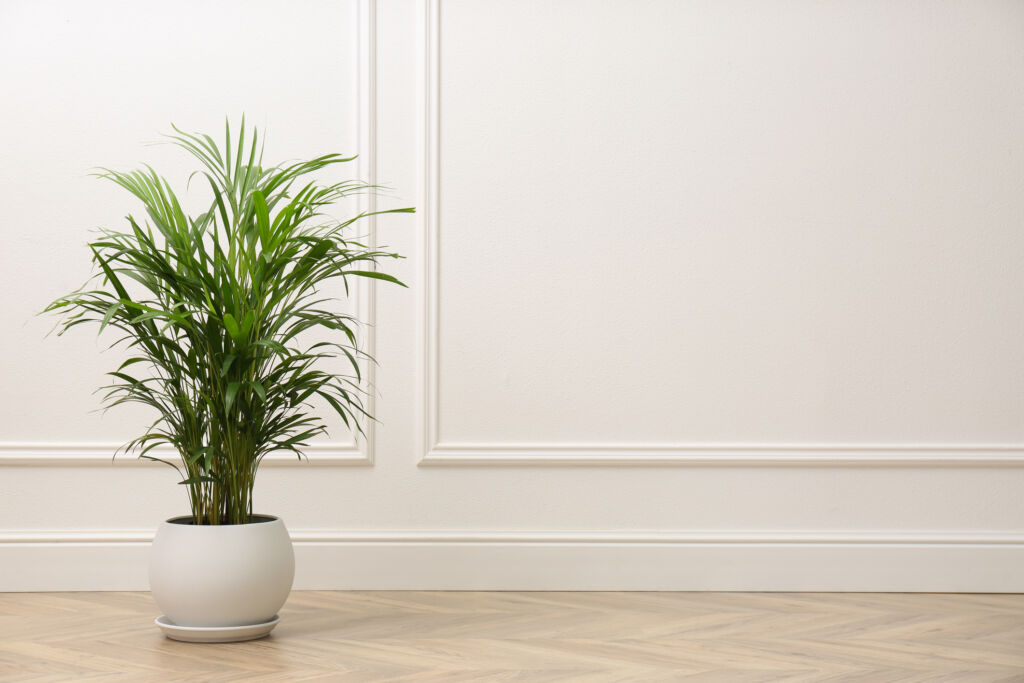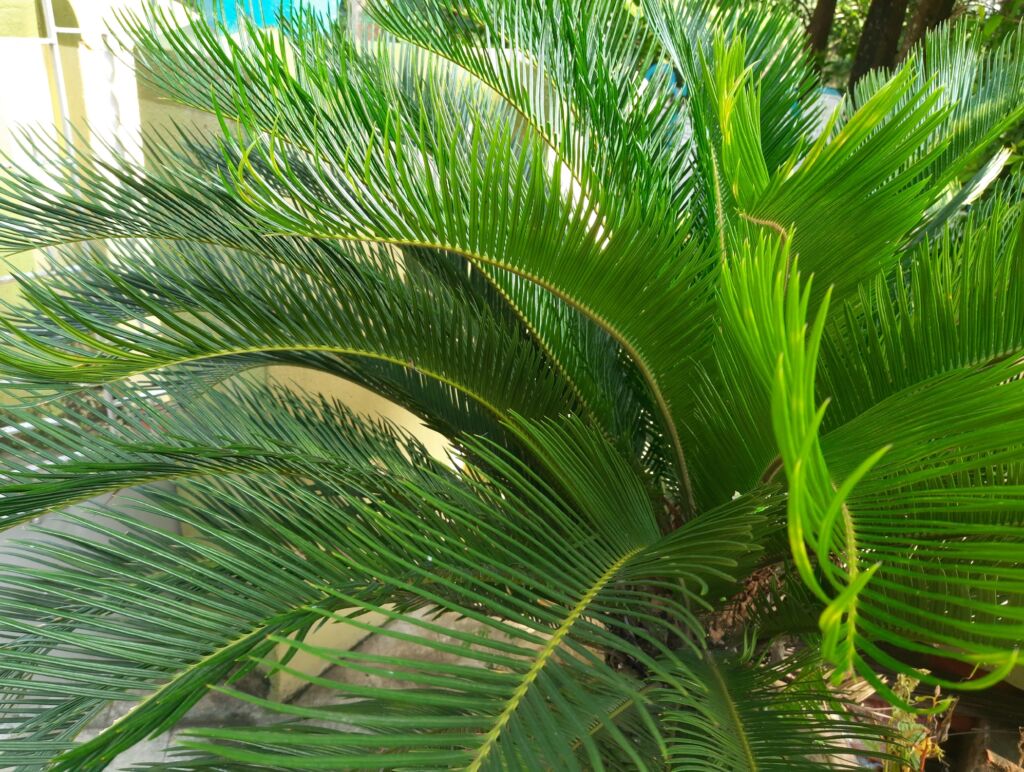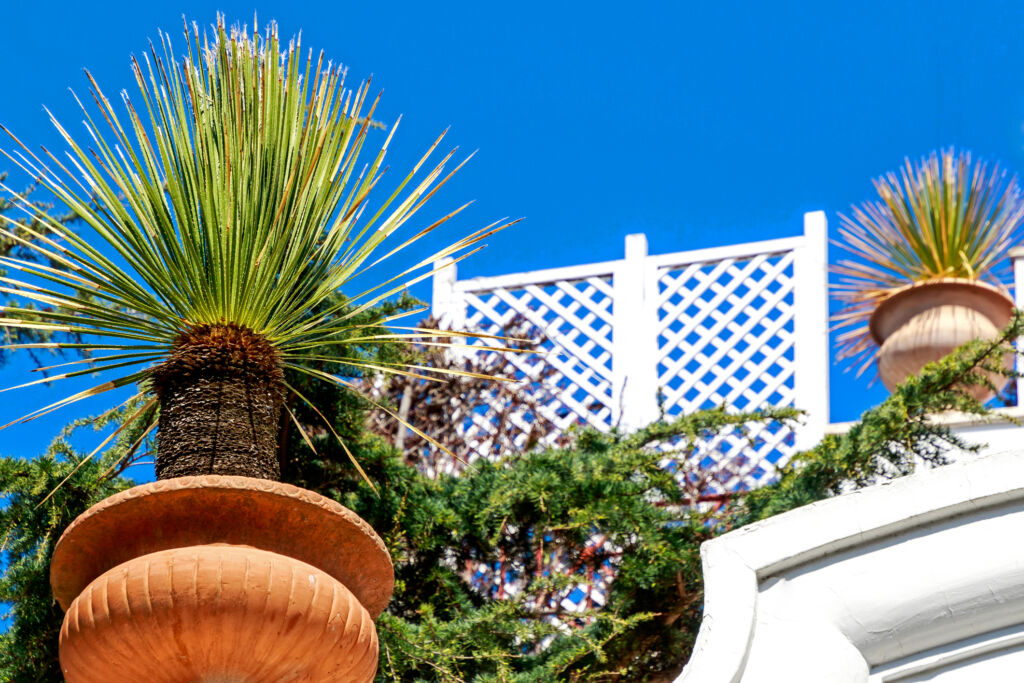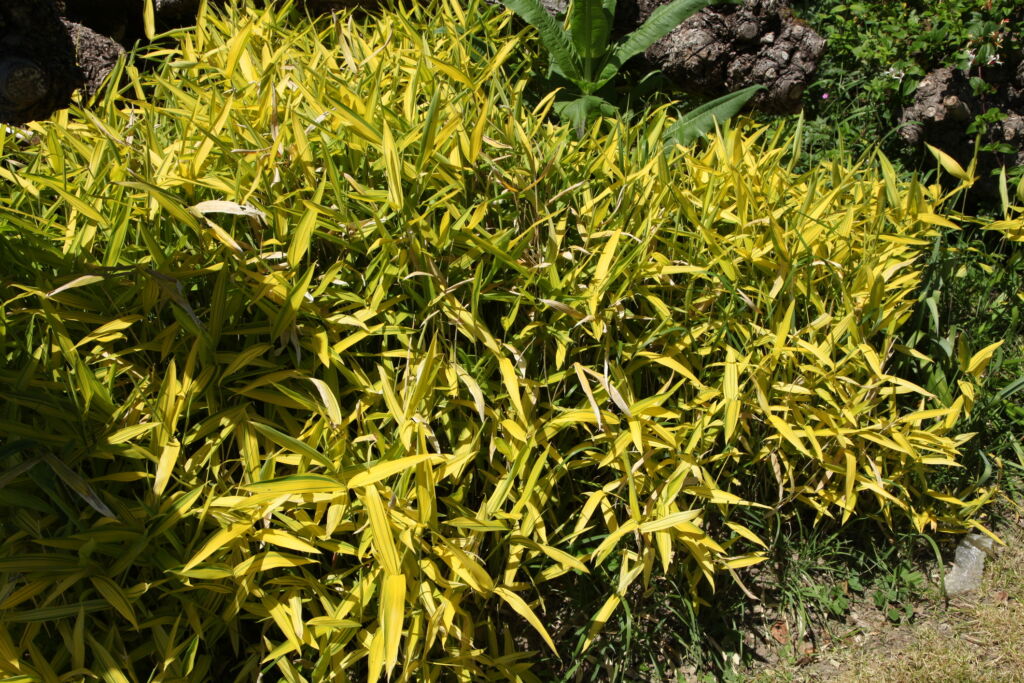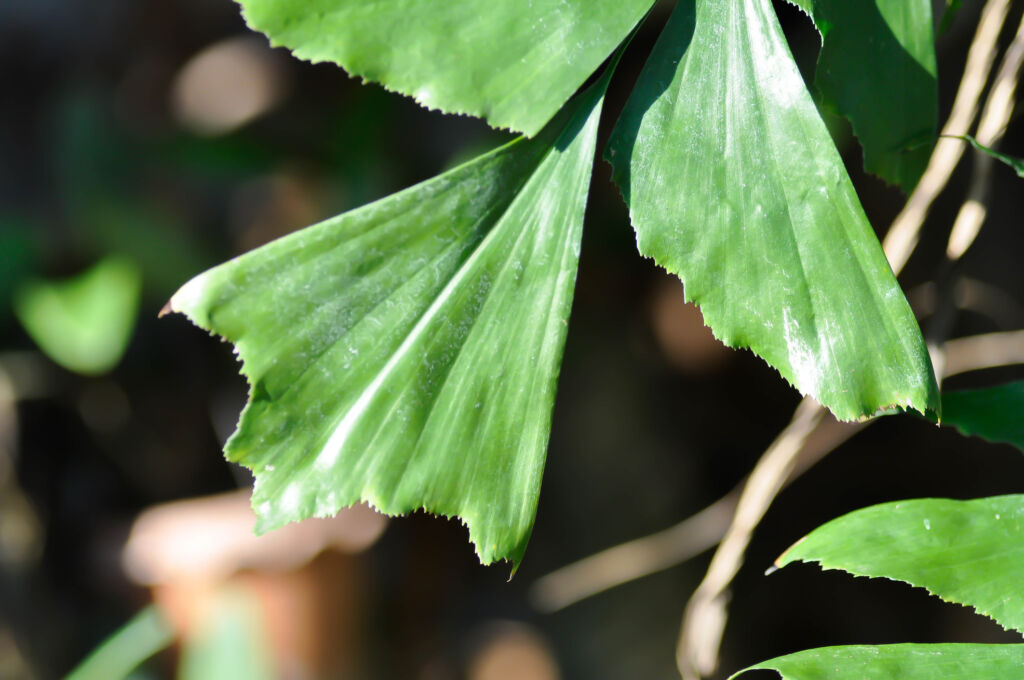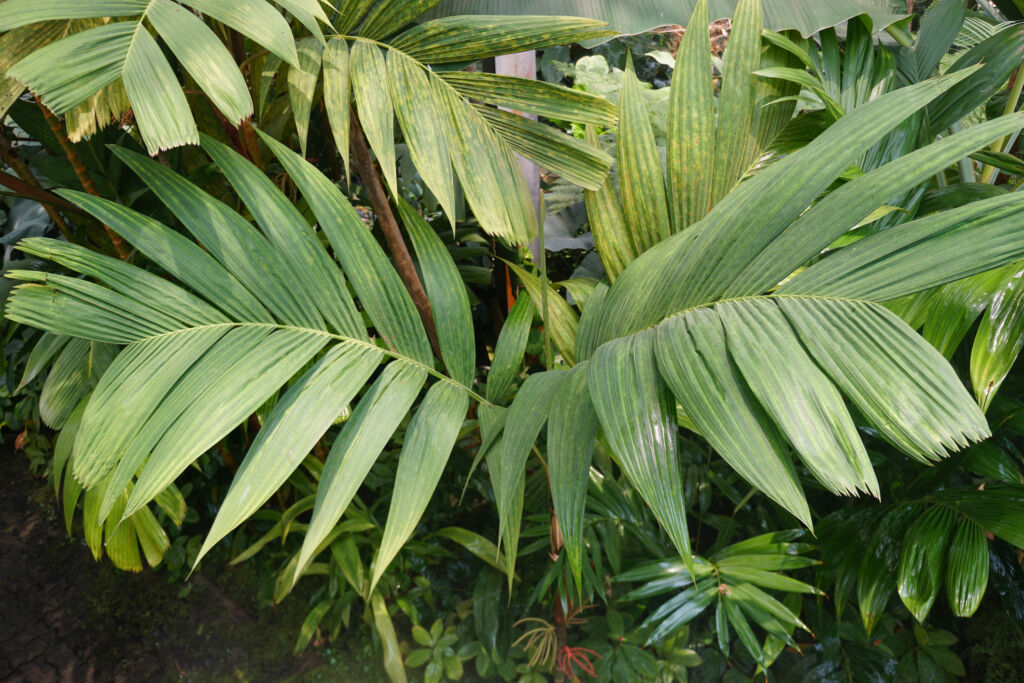HousePlantJoy is supported by our audience. When you purchase through one of our links, we may earn a small affiliate commission. As an Amazon Associate I earn from qualifying purchases. Your cost is not affected.
==================
Growing indoor palm trees can liven up any indoor living space. Here is a comprehensive guide on growing palm trees as houseplants!
Since palm trees are often associated with tropical environments, indoor palm trees can elicit feelings of relaxation and peace more than any other houseplants. Proper growing conditions and care can keep your indoor palms thriving all year long.
However, before opting for indoor palm trees, it is also worth noting that there are over 2,600 species spread over 181 genera within the Arecaceae family. While some are tropical houseplants, others grow well in subtropical conditions. One can easily distinguish between palms by looking at their large, evergreen leaves (fronds) arranged at the top of their branchless stem.
Indoor Palm Trees
In addition to being outstanding landscape trees in warmer climates, some palm trees as houseplants are an excellent addition to any indoor living space. Mature palm trees are often planted in public places and foyers to add elegance and distinctly tropical air. On the other hand, small, immature palm trees are great for adding greenery to indoor living spaces.
Moreover, it is tantalizing to see palms as tropical plants that need plenty of water and sunlight to thrive and some desert varieties that don’t like to sit in the water. So, careful research to identify palm trees is crucial to determine what types can thrive indoors.
Before we talk about our favorite palm trees as houseplants, let’s discuss how to care for indoor palms.
Indoor Palm Trees Care Tips
To grow well, outdoor palm trees need full sun, annual fertilizer, and less watering. At the same time, immature palm trees require thorough, frequent watering until they become healthy mature trees. Additionally, if you plan to grow palms indoors, keeping the soil moist is essential but avoid waterlogging.
Indoor Palm Trees
Here are a few essential care tips for indoor palm trees:
· Indoor Palm Trees Light Requirement
One deciding factor that makes palms ideal houseplants is their ability to adjust in low-light conditions. Remember that while most palm trees are incredibly tolerant or prefer shade, some varieties may fail to thrive if you expose them to excessive direct sunlight.
So, when growing palm trees as houseplants, choose varieties that can tolerate low light or prefer bright, indirect light, especially during the colder temperatures.
· Indoor Palm Trees Soil Requirement
In addition to light, the soil is another deciding factor for your indoor palm trees. Ideally, the best soil for indoor palms is a loose and porous mixture like peat moss, shredded bark, or leaf mold. You can also buy a few dollars to buy cactus or palm soil mixtures that are explicitly made for palms.
However, since palms are tolerant, they can grow just fine in standard potting soil. Moreover, if you tend to forget to water your houseplants more often, it would be great to mix some vermiculite or peat moss to help retain water.
· Indoor Palm Trees Watering
Remember that when growing palm trees as houseplants, some varieties may fail to survive if they sit in water for too long. So, successfully growing an indoor palm tree ensures that the soil has good drainage. Despite the fact that palms grow well in warm regions, it doesn’t mean they like waterlogging.
In fact, several palm varieties grow best in slightly sandy soils with proper drainage. Moreover, ensure not to let your tree’s root ball sit in the water and allow the soil to dry out between watering. In addition, using terracotta or clay vessels to grow houseplants can help wick excess moisture.
· Indoor Palm Trees Temperature and Humidity Requirement
While a few palm varieties can be incredibly tolerant and thrive in frigid temperatures, others, like coconut palms, are strictly allergic to cold temperatures and cannot survive. However, cold-hardy palm trees like kentia palm and parlor palm are the best indoor plants for colder climates. As a general rule, do not expose your indoor palm trees to temperatures below 50 degrees Fahrenheit.
· Indoor Palm Trees Fertilization
Fertilizer is essential for growing a healthy palm houseplant. Palm trees prefer fertilization, especially during the growing season. It would be wise to choose a fertilizer containing all the essential micronutrients, manganese, and potassium.
Remember that potassium-rich fertilizers can help avoid potassium deficiency, especially in palm trees with yellowish or brownish fronds. If you notice such issues, it’s time to increase your fertilizer feeding.
Our Favorite Indoor Palm Trees
Here are our favorite indoor palm trees that are easy to grow and add a breezy, tropical feel to your living space:
1. Chinese Fan Palm (Livistona Chinesis)
Not everyone has suitable growing conditions to relish a taste of the tropics. However, this doesn’t mean gardening enthusiasts stop enjoying tropical plants’ elegant and relaxed feel. Chinese fan palm tree is one of the most popular indoor palm trees you can grow indoors.
Chinese Fan Palm Indoor Tree
The star-shaped leaves of this indoor palm set it apart from others with classic feathery fronds. While the houseplant is a slow-grower, mature Chinese fan palm species can reach up to 15 feet. These plants are pretty tolerant and are not overly particular about the growing conditions. This makes Chinese fan palms a perfect option for experienced and novice gardeners alike.
That said, remember that providing adequate warmth, the right amount of light, and sufficient watering is still essential to keep your indoor palm tree thriving. Moreover, proper soil drainage is a must whether you grow these houseplants in the ground or in a container.
Requirements
- While Chinese fan palm is tolerant to some shade, these plants prefer indirect, bright sunlight.
- They will thrive in moderately moist soil.
- Plant your tree in a large container that can easily accommodate its long taproot.
- Fertilize once a year in the spring with a slow-release fertilizer.
| Height | 15 Feet Or More |
| Width | 5 Feet |
| Growing Season | Late August to September |
| Varieties | Emerald Green Foliage |
| Toxicity | Non-Toxic |
2. Areca Palm (Dypsis Lutescens)
The plant is non-toxic to both dogs and cats. It is one of the most accessible palm trees as houseplants that you can grow indoors. While the areca palm or butterfly palm is native to Madagascar, the plant is still considered an endangered species in its native region. When driving down in a warm stateside climate, you will see these tall, appealing, clumping trees in abundance.
Areca Palm
In addition to planting these plants outdoors, the areca palm is a low-maintenance indoor palm and pretty tolerant to low-light conditions. The plant yields large, feathery greenish fronds with a gentle curve. Its gold-colored stems and tight clustering look like genuine bamboo.
Moreover, remember that areca palm is susceptible to root rot, so when growing these palm trees as houseplants, ensure to provide them with a well-drained container. In addition, these plants are also susceptible to fluoride, so water them with rainfall or distilled water when the soil dries up.
Furthermore, areca palm, as houseplants, loves to get sunshine, so putting them near a sunny window or in a bright room, especially during the colder months, will promote healthy growth.
Requirements
- Areca palm can tolerate low-light conditions. However, they prefer to soak up the sunshine.
- Placing your indoor palm in a bright room or near a sunny window in winter will help with healthy growth.
- Avoid watering with tap water; instead, use distilled water when the soil starts to dry up.
- Fertilize once a year in the spring with a slow-release fertilizer.
| Height | 12-30 Feet |
| Width | 8-10 Feet |
| Growing Season | Spring and Summer |
| Varieties | Yellow Green Stem with Light Green Fronds |
| Toxicity | Non-Toxic |
3. Ponytail Palm (Beaucarnea recurvata)
This is one of my favorite indoor palm trees. While technically, it is not a palm tree, it shares a similar structure. Apart from its striking beauty that can easily dress up any indoor living space, ponytail palm is also among the houseplants that require the lowest maintenance.
Ponytail Palm Tree
This houseplant is native to Mexico, where it grows in abundance, with some species hitting up to 350 years of age. Moreover, another plus point in favor of ponytail palm is its non-toxic nature, which means the plant is safe for both children and pets in your home.
Furthermore, the slow-growing nature of the ponytail is a significant factor that makes it a perfect indoor palm houseplant for both experienced and novice gardeners. You don’t have to worry about its size or repotting your plant.
Requirements
- While ponytail palm houseplants love to soak in bright, indirect sunlight, they can do well in medium-light conditions as well.
- It is a perfect houseplant for regions with dry environments.
- Ensure to let the soil dry out between watering. Ideally, you should water it every two weeks.
- Fertilization twice a year (spring and summer) should be enough to encourage healthy growth.
| Height | Up to 30 Feet |
| Width | 3-5 Feet |
| Growing Season | Spring and Summer |
| Toxicity | Non-Toxic |
4. Majesty Palm (Ravenea Rivularis)
Majesty palm is another outstanding indoor palm tree that you can grow indoors. Its tolerant behavior and slow growth rate are two specialties that make it a perfect indoor palm. On the other hand, there are a couple of drawbacks that you should also keep in mind while choosing the plant.
Majesty Palm Indoor Tree
Firstly, it requires constant humidity. Secondly, majesty palm needs adequate moisture to thrive. So, if you are confident in providing your right palm conditions and growing environment, majesty palm can be an excellent plant to grow indoors and outdoors alike.
Moreover, placing your palm in a moist area like a bathroom or kitchen would be nice. It will help your plant to cultivate a graceful stand of dark green fronds that can liven up any corner of your indoor living space.
Requirements
- Majesty palm tree loves bright, indirect light throughout the day.
- Make sure to keep the soil moist.
- Fertilization during the growing season will promote healthy growth.
| Height | 10-12 Feet |
| Width | 4-18 Feet |
| Growing Season | Spring and Summer |
| Toxicity | Non-Toxic |
5. Cascade Palm (Chamaedorea cataractarum)
Cascade palm has become a favorite plant among gardening enthusiasts looking to grow palm trees as houseplants. It brings a tropical life in and outside your home, and planters tend to adore its cascading sets of fronds and trunkless visage. The dense foliage of cascade palm looks so soothing to the eyes and can fill up an empty corner in your home.
Cascade Palm
Cascade palms are native to Central American jungles and known for their glossy, dark green fronds on thin shoots. However, despite being an attractive option among gardeners, houseplant requires high maintenance, which makes them hard to grow and maintain, especially for novice gardeners.
Requirements
- Indoor cascade palm trees require well-drained, moist organic soil. This type of soil allows your palm to grow to its full potential.
- Unlike some other indoor palm trees, cascade palm trees prefer low-light conditions. They thrive in places where they get a partial shade or indirect light.
- It requires regular watering but be careful to avoid overwatering.
- Additionally, cascade palm requires fertilizer thrice a year (autumn, spring, and summer).
| Height | 3-6 Feet |
| Width | 5 Feet |
| Growing Season | Spring and Summer |
| Toxicity | Non-Toxic |
6. Sago Palm (Cycas Revoluta)
Despite its name, the sago palm is not technically an actual palm tree. This relatively slow-growing plant produces long green fronds growing from a trunk that does not branch out. Additionally, while the plant does produce nuts, you should not expect it to bloom or fruit.
Sago Palm Indoor Tree
Sago’s palm is native to warm regions of southern China and Japan. However, you can grow these palm trees as houseplants in cooler climates. Additionally, these plants produce feather-like foliage in a symmetrical ring that looks incredible.
If you plan to grow sago palm as your first-ever palm houseplant, you are already in for a treat. It produces stiff fronds that grow in an upward direction from a small, hairy trunk. While growing these palm trees as houseplants, choose a location where they can get filtered light for at least six hours.
Requirements
- Sago’s palm prefers six hours of indirect or filtered light daily. However, the plant can tolerate some shade as well.
- Provide your palm a moderately moist soil.
- The houseplant can grow well even if you don’t water it for longer periods.
- Sago’s palm isn’t fussy, so it can tolerate whatever humidity levels it gets.
- Feed twice a year in spring and mid-summer for healthy growth.
| Height | 3-10 Feet |
| Width | 4-8 Feet |
| Growing Season | Spring and Mid-Summer |
| Toxicity | Toxic to both Humans and Pets |
7. Yucca Palm (Yucca elephantipes)
Sometimes, it is essential to know enough about identifying different plant species, especially palms. For instance, Yucca allifolia, or Spanish bayonet, features razor-sharp leaves and makes an excellent outdoor palm tree. On the other hand, yucca elephantipes is a spineless palm. While it also has pointy tip leaves, the houseplant is unlikely to draw blood like its cousin.
Yucca Palm
It produces tough, strappy green leaves that emerge from an appealing trunk. Yucca palm is incredibly drought-tolerant and can grow well in partial shade or full sun alike. Since these plants are also low-maintenance and slow-growing plants, they make excellent houseplants. Furthermore, they are easy to propagate, so you can share the love with others.
Requirements
- Yucca palms are incredibly sensitive to overwatering and can develop root rot. So, watering once a week may be sufficient.
- Also, ensure that your palm has excellent drainage to prevent waterlogging.
- Water once every few weeks during cold temperatures.
- They like bright, indirect light when grown indoors. Direct sunlight can trigger white spots on the leaves with crispy brown tips.
- Fertilize a year thrice with a slow-release fertilizer.
| Height | 5 Feet |
| Width | 1.8 Feet |
| Growing Season | All Year Round |
| Toxicity | Moderately Poisonous |
8. Dwarf Bamboo Palm (Chamaedorea radicalis)
The dwarf bamboo palm is a miniature variant of the bamboo plant and has several varieties. The plant originates from Japan and is incredibly winter-resistant. While you can grow the dwarf bamboo plant in the garden, it is also an excellent container plant. However, if you plan to grow it indoors in a container, ensure to protect it from frost.
The Dwarf Bamboo
The dwarf bamboo palm is a simple to care plant, making it an excellent pick for experienced and novice gardeners alike. For instance, it needs little to no maintenance and can thrive in different light and humidity environments. While growing in a container indoors, dwarf bamboo palms produce dark, thick leaves and can grow up to 6 feet.
Requirements
- The dwarf bamboo palm grows well in temperatures between 65-80 degrees Fahrenheit.
- While the bamboo plant can thrive in almost any soil, ensure to provide it a well-draining soil.
- It needs regular fertilization, so you can feed it with a slow-release or bamboo-specific fertilizer.
- Try to keep your plant in a sunny to half-shady place.
| Height | 6 Feet |
| Width | 3-4 Feet |
| Growing Season | All Year Round |
| Toxicity | Non-Toxic |
9. Fishtail Palm (Caryota Mitis)
As the name suggests, the fishtail palm plant name is tied to its chopped leaves that resemble fishtails. Despite being a challenging plant to maintain indoors, it is one of the elegant indoor palm trees that can light up your indoor space. However, keep in mind that Fishtail palm trees, as houseplants need plenty of light and consistent watering.
Fishtail Palm
An immature fishtail palm plant is a slow-grower and easy to repot. However, mature fishtail palms can grow as high as 20 feet, meaning their height and weight make repotting arduous.
Requirements
- While fishtail palms need consistent watering, ensure to let the soil dry slightly between watering.
- Since these palms need direct or bright, indirect light, keep them near a sunny window.
- Avoid keeping your fishtail palm in low-light conditions.
| Height | 6-10 Feet |
| Width | 4-5 Feet |
| Growing Season | Late Spring to Summer |
| Toxicity | Toxic |
10. Ivory Cane Palm (Pinanga Coronata)
Ivory Cane makes excellent palm trees as houseplants. They feature a cluster of stems as well as a white crown shaft that becomes green as they mature. You can grow these palms both indoors and outdoors. While growing outdoors, the ivory cane can grow as high as 20 feet. However, growing these plants in containers indoors means they can grow up to 12 feet.
Ivory Cane Palm
A healthy ivory cane palm bears pink blossoms that turn red as they grow, followed by purple berries. Moreover, if you want to keep your palm at its current size, grow it in a tiny pot.
Requirements
- Ideally, a bright spot with direct sunlight can help keep your plant growing and healthy.
- Try to keep the soil moist but not soggy.
- Allow the top of the soil (3 inches) to dry between watering.
- Feeding quality fertilizers will promote strong, healthy growth.
| Height | 4-10 Feet |
| Width | 4-8 Feet |
| Toxicity | Toxic |
Wrapping Up
There you have it – our favorite ten indoor palm trees. There are hundreds of palm species that you can grow indoors. However, be sure to pick one that suits your location. After reading our article, we believe you will be able to choose a suitable palm tree for your indoors.
You Might Also Like the following:

